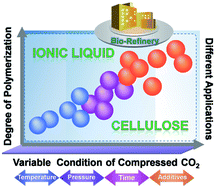Studies on staged precipitation of cellulose from an ionic liquid by compressed carbon dioxide†
Abstract
An efficient method to precipitate and refine cellulose from ionic liquids (ILs) using compressed CO2 as a gas anti-solvent was proposed. 1-Butyl-3-methylimidazolium acetate ([Bmim]OAc) was used as the solvent of microcrystalline cellulose (MCC). The yield and degree of polymerization (DP) value of the regenerated cellulose can be finely tuned by controlling the temperature, pressure, reaction time and addition of aprotic polar solvents. For gaining a better understanding of the possible cellulose precipitation mechanism, the possible carboxylation reaction, volume expansion and solvatochromic parameters of the solution caused by compressed CO2 were investigated. The solvent strength of the system can be adjusted by the pressure and temperature of CO2. The regenerated cellulose samples from [Bmim]OAc by addition of different anti-solvents were characterized by solid-state cross-polarization/magic angle spinning (CP/MAS) 13C NMR, X-ray diffraction (XRD) and atomic force microscopy (AFM). In addition, the energy consumption analysis during the anti-solvent process was discussed. The precipitation and staged bio-refining of cellulose from IL is easy, sustainable and cost-efficient.


 Please wait while we load your content...
Please wait while we load your content...